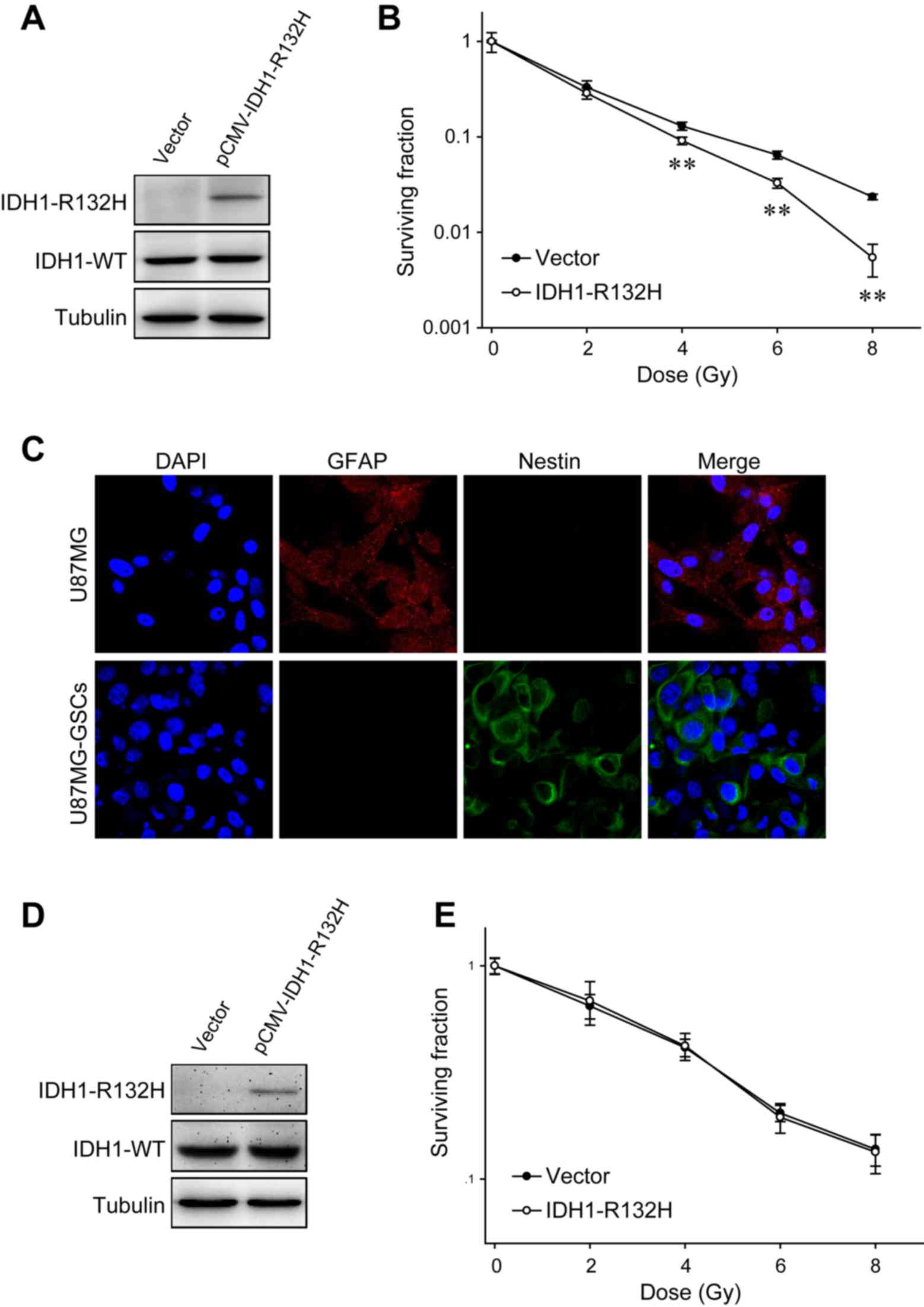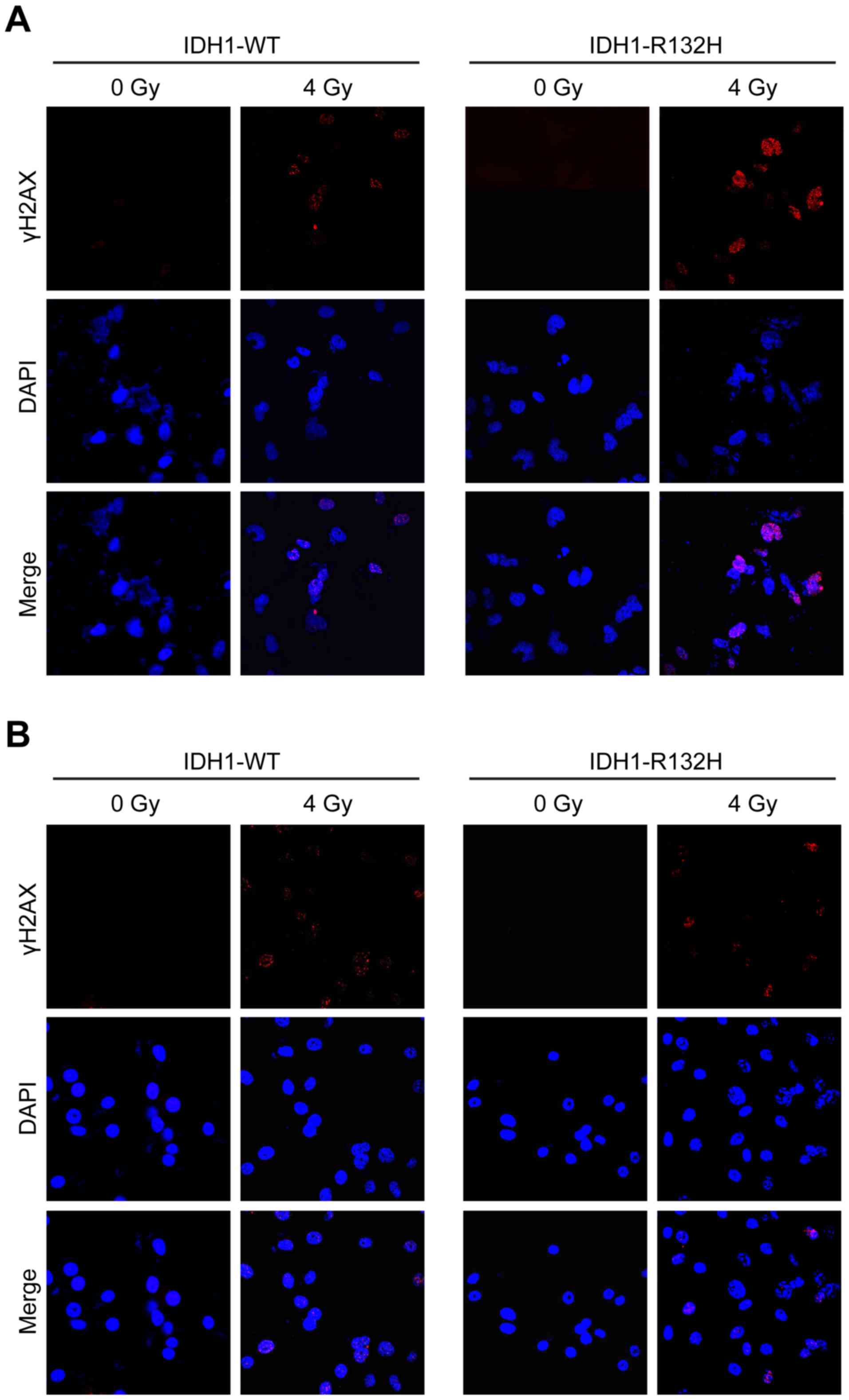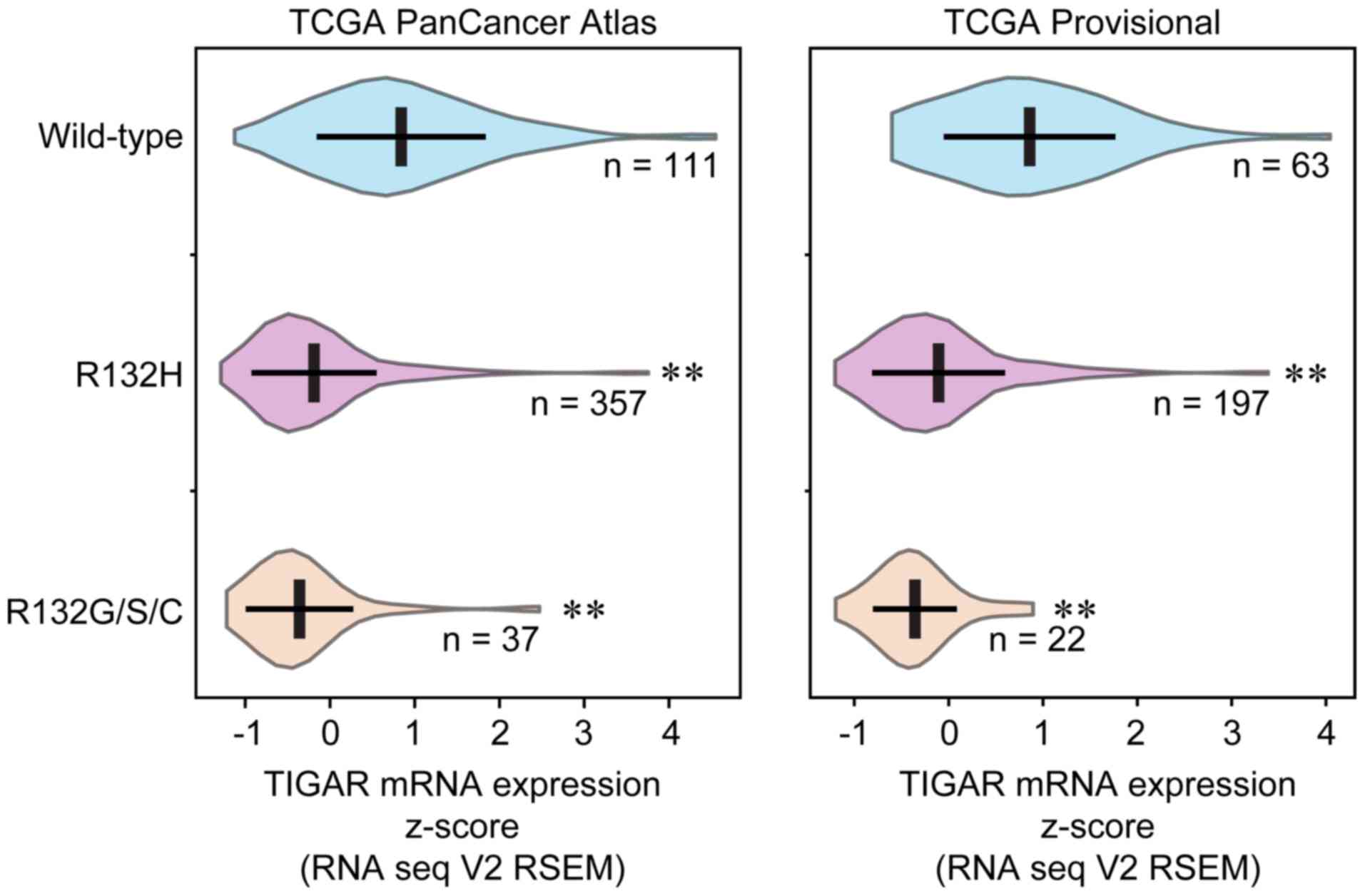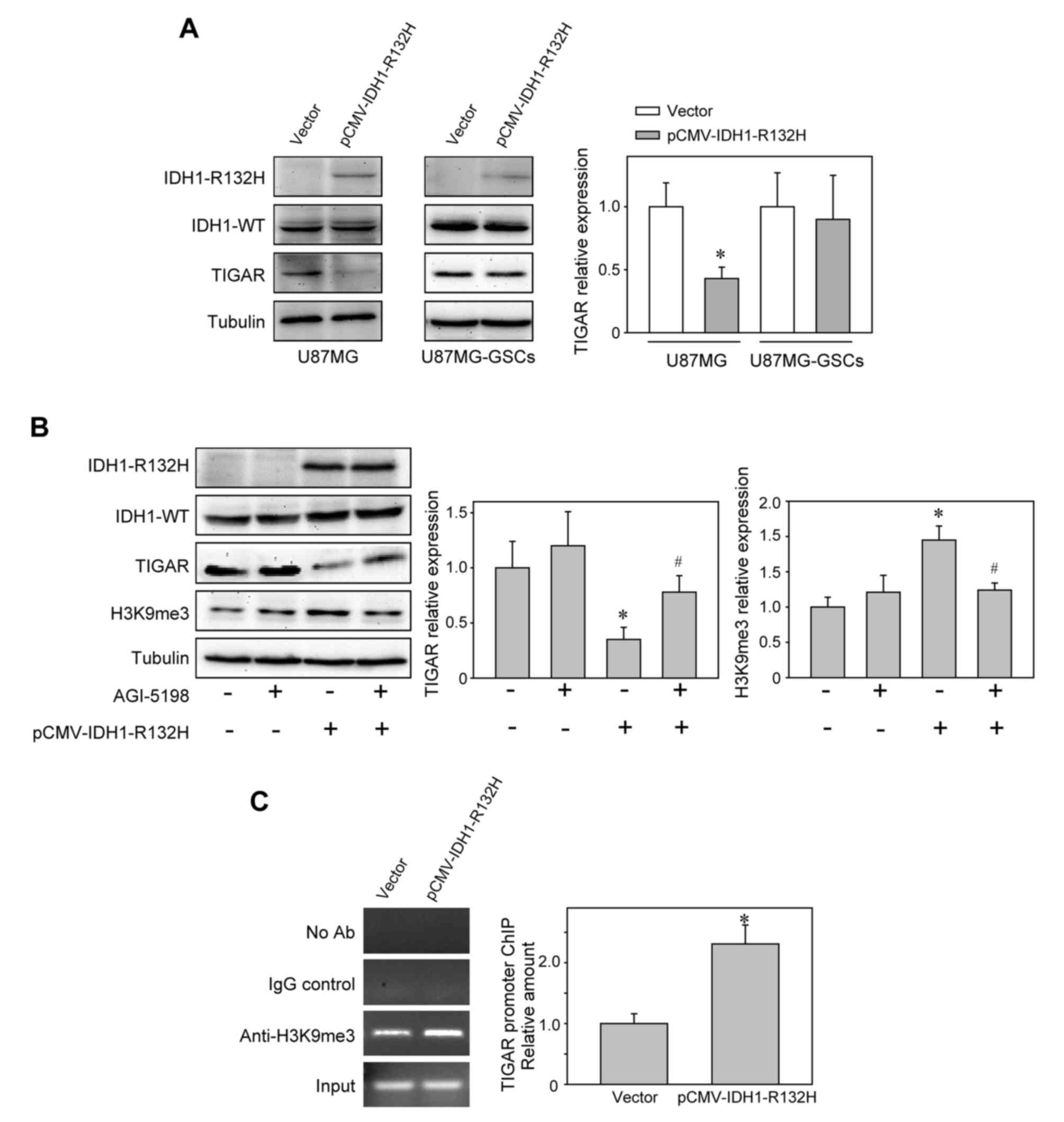|
1
|
Parsons DW, Jones S, Zhang X, Lin JC,
Leary RJ, Angenendt P, Mankoo P, Carter H, Siu IM, Gallia GL, et
al: An integrated genomic analysis of human glioblastoma
multiforme. Science. 321:1807–1812. 2008. View Article : Google Scholar : PubMed/NCBI
|
|
2
|
Kang MR, Kim MS, Oh JE, Kim YR, Song SY,
Seo SI, Lee JY, Yoo NJ and Lee SH: Mutational analysis of IDH1
codon 132 in glioblastomas and other common cancers. Int J Cancer.
125:353–355. 2009. View Article : Google Scholar : PubMed/NCBI
|
|
3
|
Yan H, Parsons DW, Jin G, McLendon R,
Rasheed BA, Yuan W, Kos I, Batinic-Haberle I, Jones S, Riggins GJ,
et al: IDH1 and IDH2 mutations in gliomas. N Engl J Med.
360:765–773. 2009. View Article : Google Scholar : PubMed/NCBI
|
|
4
|
Waitkus MS, Diplas BH and Yan H:
Biological role and therapeutic potential of IDH mutations in
cancer. Cancer Cell. 34:186–195. 2018. View Article : Google Scholar : PubMed/NCBI
|
|
5
|
Xu W, Yang H, Liu Y, Yang Y, Wang P, Kim
SH, Ito S, Yang C, Wang P, Xiao MT, et al: Oncometabolite
2-hydroxyglutarate is a competitive inhibitor of
α-ketoglutarate-dependent dioxygenases. Cancer Cell. 19:17–30.
2011. View Article : Google Scholar : PubMed/NCBI
|
|
6
|
Philip B, Yu DX, Silvis MR, Shin CH,
Robinson JP, Robinson GL, Welker AE, Angel SN, Tripp SR, Sonnen JA,
et al: Mutant IDH1 promotes glioma formation in vivo. Cell Rep.
23:1553–1564. 2018. View Article : Google Scholar : PubMed/NCBI
|
|
7
|
Grassian AR, Parker SJ, Davidson SM,
Divakaruni AS, Green CR, Zhang X, Slocum KL, Pu M, Lin F, Vickers
C, et al: IDH1 mutations alter citric acid cycle metabolism and
increase dependence on oxidative mitochondrial metabolism. Cancer
Res. 74:3317–3331. 2014. View Article : Google Scholar : PubMed/NCBI
|
|
8
|
Izquierdo-Garcia JL, Viswanath P, Eriksson
P, Chaumeil MM, Pieper RO, Phillips JJ and Ronen SM: Metabolic
reprogramming in mutant IDH1 glioma cells. PLoS One.
10:e01187812015. View Article : Google Scholar : PubMed/NCBI
|
|
9
|
Sanson M, Marie Y, Paris S, Idbaih A,
Laffaire J, Ducray F, El Hallani S, Boisselier B, Mokhtari K,
Hoang-Xuan K and Delattre JY: Isocitrate dehydrogenase 1 codon 132
mutation is an important prognostic biomarker in gliomas. J Clin
Oncol. 27:4150–4154. 2009. View Article : Google Scholar : PubMed/NCBI
|
|
10
|
Cairncross JG, Wang M, Jenkins RB, Shaw
EG, Giannini C, Brachman DG, Buckner JC, Fink KL, Souhami L,
Laperriere NJ, et al: Benefit from procarbazine, lomustine, and
vincristine in oligodendroglial tumors is associated with mutation
of IDH. J Clin Oncol. 32:783–790. 2014. View Article : Google Scholar : PubMed/NCBI
|
|
11
|
Tran AN, Lai A, Li S, Pope WB, Teixeira S,
Harris RJ, Woodworth DC, Nghiemphu PL, Cloughesy TF and Ellingson
BM: Increased sensitivity to radiochemotherapy in IDH1 mutant
glioblastoma as demonstrated by serial quantitative MR volumetry.
Neuro Oncol. 16:414–420. 2014. View Article : Google Scholar : PubMed/NCBI
|
|
12
|
Waitkus MS, Diplas BH and Yan H:
Isocitrate dehydrogenase mutations in gliomas. Neuro Oncol.
18:16–26. 2016. View Article : Google Scholar : PubMed/NCBI
|
|
13
|
Watanabe T, Nobusawa S, Kleihues P and
Ohgaki H: IDH1 mutations are early events in the development of
astrocytomas and oligodendrogliomas. Am J Pathol. 174:1149–1153.
2009. View Article : Google Scholar : PubMed/NCBI
|
|
14
|
Johannessen TA, Mukherjee J, Viswanath P,
Ohba S, Ronen SM, Bjerkvig R and Pieper RO: Rapid conversion of
mutant IDH1 from driver to passenger in a model of human
gliomagenesis. Mol Cancer Res. 14:976–983. 2016. View Article : Google Scholar : PubMed/NCBI
|
|
15
|
Li S, Chou AP, Chen W, Chen R, Deng Y,
Phillips HS, Selfridge J, Zurayk M, Lou JJ, Everson RG, et al:
Overexpression of isocitrate dehydrogenase mutant proteins renders
glioma cells more sensitive to radiation. Neuro Oncol. 15:57–68.
2013. View Article : Google Scholar : PubMed/NCBI
|
|
16
|
Shi J, Sun B, Shi W, Zuo H, Cui D, Ni L
and Chen J: Decreasing GSH and increasing ROS in chemosensitivity
gliomas with IDH1 mutation. Tumour Biol. 36:655–662. 2015.
View Article : Google Scholar : PubMed/NCBI
|
|
17
|
Kessler J, Güttler A, Wichmann H, Rot S,
Kappler M, Bache M and Vordermark D: IDH1(R132H) mutation causes a
less aggressive phenotype and radiosensitizes human malignant
glioma cells independent of the oxygenation status. Radiother
Oncol. 116:381–387. 2015. View Article : Google Scholar : PubMed/NCBI
|
|
18
|
Zhang Y, Chen F, Tai G, Wang J, Shang J,
Zhang B, Wang P, Huang B, Du J, Yu J, et al: TIGAR knockdown
radiosensitizes TrxR1-overexpressing glioma in vitro and in vivo
via inhibiting Trx1 nuclear transport. Sci Rep. 7:429282017.
View Article : Google Scholar : PubMed/NCBI
|
|
19
|
Zhang H, Gu C, Yu J, Wang Z, Yuan X, Yang
L, Wang J, Jia Y, Liu J and Liu F: Radiosensitization of glioma
cells by TP53-induced glycolysis and apoptosis regulator knockdown
is dependent on thioredoxin-1 nuclear translocation. Free Radic
Biol Med. 69:239–248. 2014. View Article : Google Scholar : PubMed/NCBI
|
|
20
|
Bensaad K, Tsuruta A, Selak MA, Vidal MN,
Nakano K, Bartrons R, Gottlieb E and Vousden KH: TIGAR, a
p53-inducible regulator of glycolysis and apoptosis. Cell.
126:107–120. 2006. View Article : Google Scholar : PubMed/NCBI
|
|
21
|
Karpel-Massler G, Ishida CT, Bianchetti E,
Zhang Y, Shu C, Tsujiuchi T, Banu MA, Garcia F, Roth KA, Bruce JN,
et al: Induction of synthetic lethality in IDH1-mutated gliomas
through inhibition of Bcl-xL. Nat Commun. 8:10672017. View Article : Google Scholar : PubMed/NCBI
|
|
22
|
Pollard SM, Yoshikawa K, Clarke ID, Danovi
D, Stricker S, Russell R, Bayani J, Head R, Lee M, Bernstein M, et
al: Glioma stem cell lines expanded in adherent culture have
tumor-specific phenotypes and are suitable for chemical and genetic
screens. Cell Stem Cell. 4:568–580. 2009. View Article : Google Scholar : PubMed/NCBI
|
|
23
|
Gao J, Aksoy BA, Dogrusoz U, Dresdner G,
Gross B, Sumer SO, Sun Y, Jacobsen A, Sinha R, Larsson E, et al:
Integrative analysis of complex cancer genomics and clinical
profiles using the cBioPortal. Sci Signal. 6:pl12013. View Article : Google Scholar : PubMed/NCBI
|
|
24
|
Cerami E, Gao J, Dogrusoz U, Gross BE,
Sumer SO, Aksoy BA, Jacobsen A, Byrne CJ, Heuer ML, Larsson E, et
al: The cBio cancer genomics portal: An open platform for exploring
multidimensional cancer genomics data. Cancer Discov. 2:401–404.
2012. View Article : Google Scholar : PubMed/NCBI
|
|
25
|
Li B and Dewey CN: RSEM: Accurate
transcript quantification from RNA-Seq data with or without a
reference genome. BMC Bioinformatics. 12:3232011. View Article : Google Scholar : PubMed/NCBI
|
|
26
|
Hunter JD: Matplotlib: A 2D graphics
environment. Comput Sci Eng. 9:90–95. 2007. View Article : Google Scholar
|
|
27
|
Bao S, Wu Q, McLendon RE, Hao Y, Shi Q,
Hjelmeland AB, Dewhirst MW, Bigner DD and Rich JN: Glioma stem
cells promote radioresistance by preferential activation of the DNA
damage response. Nature. 444:756–760. 2006. View Article : Google Scholar : PubMed/NCBI
|
|
28
|
Rizzo AE and Yu JS: Radiation therapy for
glioma stem cells. Adv Exp Med Biol. 853:85–110. 2015. View Article : Google Scholar : PubMed/NCBI
|
|
29
|
Singh SK, Clarke ID, Terasaki M, Bonn VE,
Hawkins C, Squire J and Dirks PB: Identification of a cancer stem
cell in human brain tumors. Cancer Res. 63:5821–5828.
2003.PubMed/NCBI
|
|
30
|
Santivasi WL and Xia F: Ionizing
radiation-induced DNA damage, response, and repair. Antioxid Redox
Signal. 21:251–259. 2014. View Article : Google Scholar : PubMed/NCBI
|
|
31
|
Rohle D, Popovici-Muller J, Palaskas N,
Turcan S, Grommes C, Campos C, Tsoi J, Clark O, Oldrini B,
Komisopoulou E, et al: An inhibitor of mutant IDH1 delays growth
and promotes differentiation of glioma cells. Science. 340:626–630.
2013. View Article : Google Scholar : PubMed/NCBI
|
|
32
|
Han X, Xue X, Zhou H and Zhang G: A
molecular view of the radioresistance of gliomas. Oncotarget.
8:100931–100941. 2017. View Article : Google Scholar : PubMed/NCBI
|
|
33
|
Mohrenz IV, Antonietti P, Pusch S, Capper
D, Balss J, Voigt S, Weissert S, Mukrowsky A, Frank J, Senft C, et
al: Isocitrate dehydrogenase 1 mutant R132H sensitizes glioma cells
to BCNU-induced oxidative stress and cell death. Apoptosis.
18:1416–1425. 2013. View Article : Google Scholar : PubMed/NCBI
|
|
34
|
Molenaar RJ, Botman D, Smits MA, Hira VV,
van Lith SA, Stap J, Henneman P, Khurshed M, Lenting K, Mul AN, et
al: Radioprotection of IDH1-mutated cancer cells by the IDH1-mutant
inhibitor AGI-5198. Cancer Res. 75:4790–4802. 2015. View Article : Google Scholar : PubMed/NCBI
|
|
35
|
Khanna KK and Jackson SP: DNA
double-strand breaks: Signaling, repair and the cancer connection.
Nat Genet. 27:247–254. 2001. View
Article : Google Scholar : PubMed/NCBI
|
|
36
|
Ohba S, Mukherjee J, See WL and Pieper RO:
Mutant IDH1-driven cellular transformation increases RAD51-mediated
homologous recombination and temozolomide resistance. Cancer Res.
74:4836–4844. 2014. View Article : Google Scholar : PubMed/NCBI
|
|
37
|
Sulkowski PL, Corso CD, Robinson ND,
Scanlon SE, Purshouse KR, Bai H, Liu Y, Sundaram RK, Hegan DC, Fons
NR, et al: 2-Hydroxyglutarate produced by neomorphic IDH mutations
suppresses homologous recombination and induces PARP inhibitor
sensitivity. Sci Transl Med. 9:2017. View Article : Google Scholar : PubMed/NCBI
|
|
38
|
Núñez FJ, Mendez FM, Kadiyala P, Alghamri
MS, Savelieff MG, Garcia-Fabiani MB, Haase S, Koschmann C,
Calinescu AA, Kamran N, et al: IDH1-R132H acts as a tumor
suppressor in glioma via epigenetic up-regulation of the DNA damage
response. Sci Transl Med. 11:2019. View Article : Google Scholar
|
|
39
|
Peña-Rico MA, Calvo-Vidal MN,
Villalonga-Planells R, Martínez-Soler F, Giménez-Bonafé P,
Navarro-Sabaté À, Tortosa A, Bartrons R and Manzano A: TP53 induced
glycolysis and apoptosis regulator (TIGAR) knockdown results in
radiosensitization of glioma cells. Radiother Oncol. 101:132–139.
2011. View Article : Google Scholar : PubMed/NCBI
|
|
40
|
Bleeker FE, Atai NA, Lamba S, Jonker A,
Rijkeboer D, Bosch KS, Tigchelaar W, Troost D, Vandertop WP,
Bardelli A and Van Noorden CJ: The prognostic IDH1(R132) mutation
is associated with reduced NADP+-dependent IDH activity
in glioblastoma. Acta Neuropathol. 119:487–494. 2010. View Article : Google Scholar : PubMed/NCBI
|
|
41
|
Atai NA, Renkema-Mills NA, Bosman J,
Schmidt N, Rijkeboer D, Tigchelaar W, Bosch KS, Troost D, Jonker A,
Bleeker FE, et al: Differential activity of NADPH-producing
dehydrogenases renders rodents unsuitable models to study IDH1R132
mutation effects in human glioblastoma. J Histochem Cytochem.
59:489–503. 2011. View Article : Google Scholar : PubMed/NCBI
|
|
42
|
M Gagné L, Boulay K, Topisirovic I, Huot
MÉ and Mallette FA: Oncogenic activities of IDH1/2 mutations: From
epigenetics to cellular signaling. Trends Cell Biol. 27:738–752.
2017. View Article : Google Scholar : PubMed/NCBI
|
|
43
|
Chowdhury R, Yeoh KK, Tian YM,
Hillringhaus L, Bagg EA, Rose NR, Leung IK, Li XS, Woon EC, Yang M,
et al: The oncometabolite 2-hydroxyglutarate inhibits histone
lysine demethylases. EMBO Rep. 12:463–469. 2011. View Article : Google Scholar : PubMed/NCBI
|
|
44
|
Lu C, Ward PS, Kapoor GS, Rohle D, Turcan
S, Abdel-Wahab O, Edwards CR, Khanin R, Figueroa ME, Melnick A, et
al: IDH mutation impairs histone demethylation and results in a
block to cell differentiation. Nature. 483:474–478. 2012.
View Article : Google Scholar : PubMed/NCBI
|
|
45
|
Inoue S, Li WY, Tseng A, Beerman I, Elia
AJ, Bendall SC, Lemonnier F, Kron KJ, Cescon DW, Hao Z, et al:
Mutant IDH1 downregulates ATM and alters DNA repair and sensitivity
to DNA damage independent of TET2. Cancer Cell. 30:337–348. 2016.
View Article : Google Scholar : PubMed/NCBI
|


















